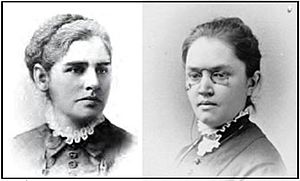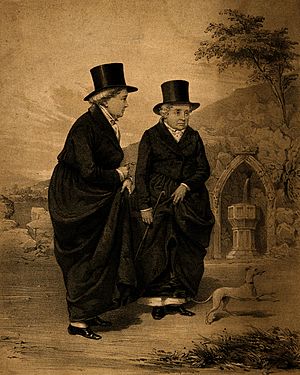Boston marriage facts for kids
A "Boston marriage" was a term used in the late 1800s and early 1900s, mostly in New England. It described two women who lived together, often without needing money from men. These women were usually wealthy and independent. Some of these relationships were very close friendships, like a partnership. Today, some might see them as romantic relationships between women, while others were not.
Contents
Where the Name Came From
Women having very close friendships or life partnerships was not new. It happened long before the term Boston marriage was used, even in England and other European countries. The name Boston marriage became popular because of a book called The Bostonians (1886) by Henry James. This book was about two unmarried women who lived together for a long time. These women were sometimes called "new women" because they were independent. Henry James's own sister, Alice James, lived in such a relationship with Katharine Peabody Loring, and she was one of his inspirations for the book.
Some women in "Boston marriages" were quite famous. For example, in the late 1700s, two Anglo-Irish women named Eleanor Butler and Sarah Ponsonby were known as a couple. They were nicknamed the Ladies of Llangollen. In the United States, a well-known example was the writer Sarah Orne Jewett and her companion Annie Adams Fields in the late 1800s. Annie was the widow of the editor of The Atlantic Monthly magazine.
A book called Surpassing the Love of Men (1981) by Lillian Faderman studied Boston marriages in detail. Later, in 2000, a play by David Mamet called Boston Marriage also helped make the term more widely known.
Living Together: The Social Side
Some women chose Boston marriages because they felt a stronger connection with other women than with men. Many of these women lived together because they had their own money from family or their jobs. They did not need to depend on men financially. Women who chose to have careers, like doctors, scientists, or professors, were part of a new group called "new women." These women were not financially dependent on men.
Educated women with careers who wanted to live with other women were generally accepted by society. They had the freedom to arrange their own lives. These women were often feminists, meaning they believed in equal rights for women. They shared similar values and were involved in social and cultural causes. They were independent in their own lives but supported each other in a society that sometimes didn't approve of women being so independent.
Until the 1920s, these living arrangements were seen as normal and respected. However, after the 1920s, people started to wonder if these relationships were more than just friendships. Because of this, fewer single women chose to live together in this way.
Wellesley College and Boston Marriages

Boston marriages were very common at Wellesley College in the late 1800s and early 1900s. They were so common that people started using the term Wellesley marriage to describe them. These relationships usually involved two women who were professors or teachers at the college. This was common from about 1870 to 1920.
In those days, women were expected to quit their jobs if they got married. So, any woman who wanted to keep her career as a professor had to find other living arrangements. Sharing a home with another single female professor was a good solution. Also, as Lillian Faderman explained, college-educated women often found more independence and support by partnering with other women. These partnerships also freed women from the responsibilities of raising children and taking care of a husband and home. This allowed professional women, like college faculty, to focus on their research and careers.
There are many examples of Wellesley marriages in history. Lillian Faderman found that in the late 1800s, out of 53 women professors at Wellesley, only one was married to a man. Most of the others lived with a female companion. Two of the most famous pairs were Katharine Lee Bates and Katharine Ellis Coman. Bates was a poetry professor and wrote the words to the song "America the Beautiful." Coman was an economic historian who wrote the first industrial history of the United States.
See also
In Spanish: Matrimonio de Boston para niños


